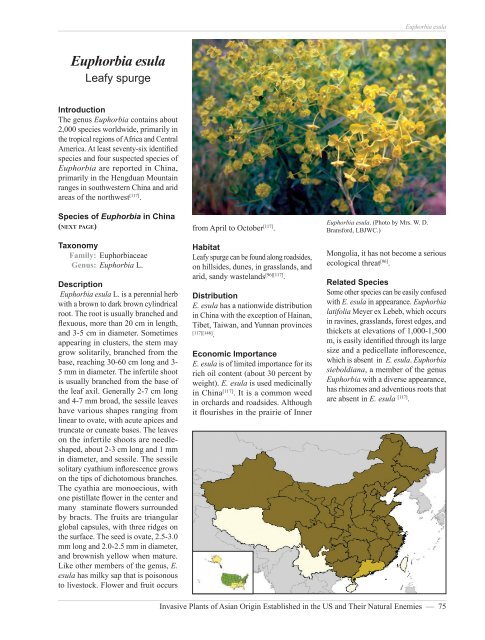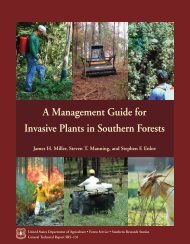Euphorbia esula
Euphorbia esula
Euphorbia esula
You also want an ePaper? Increase the reach of your titles
YUMPU automatically turns print PDFs into web optimized ePapers that Google loves.
<strong>Euphorbia</strong> <strong>esula</strong><strong>Euphorbia</strong> <strong>esula</strong>Leafy spurgeIntroductionThe genus <strong>Euphorbia</strong> contains about2,000 species worldwide, primarily inthe tropical regions of Africa and CentralAmerica. At least seventy-six identifiedspecies and four suspected species of<strong>Euphorbia</strong> are reported in China,primarily in the Hengduan Mountainranges in southwestern China and aridareas of the northwest [117] .Species of <strong>Euphorbia</strong> in China(NEXT PAGE)TaxonomyFamily: <strong>Euphorbia</strong>ceaeGenus: <strong>Euphorbia</strong> L.Description<strong>Euphorbia</strong> <strong>esula</strong> L. is a perennial herbwith a brown to dark brown cylindricalroot. The root is usually branched andflexuous, more than 20 cm in length,and 3-5 cm in diameter. Sometimesappearing in clusters, the stem maygrow solitarily, branched from thebase, reaching 30-60 cm long and 3-5 mm in diameter. The infertile shootis usually branched from the base ofthe leaf axil. Generally 2-7 cm longand 4-7 mm broad, the sessile leaveshave various shapes ranging fromlinear to ovate, with acute apices andtruncate or cuneate bases. The leaveson the infertile shoots are needleshaped,about 2-3 cm long and 1 mmin diameter, and sessile. The sessilesolitary cyathium inflorescence growson the tips of dichotomous branches.The cyathia are monoecious, withone pistillate flower in the center andmany staminate flowers surroundedby bracts. The fruits are triangularglobal capsules, with three ridges onthe surface. The seed is ovate, 2.5-3.0mm long and 2.0-2.5 mm in diameter,and brownish yellow when mature.Like other members of the genus, E.<strong>esula</strong> has milky sap that is poisonousto livestock. Flower and fruit occursfrom April to October [117] .HabitatLeafy spurge can be found along roadsides,on hillsides, dunes, in grasslands, andarid, sandy wastelands [96][117] .DistributionE. <strong>esula</strong> has a nationwide distributionin China with the exception of Hainan,Tibet, Taiwan, and Yunnan provinces[117][146].Economic ImportanceE. <strong>esula</strong> is of limited importance for itsrich oil content (about 30 percent byweight). E. <strong>esula</strong> is used medicinallyin China [117] . It is a common weedin orchards and roadsides. Althoughit flourishes in the prairie of Inner<strong>Euphorbia</strong> <strong>esula</strong>. (Photo by Mrs. W. D.Bransford, LBJWC.)Mongolia, it has not become a seriousecological threat [96] .Related SpeciesSome other species can be easily confusedwith E. <strong>esula</strong> in appearance. <strong>Euphorbia</strong>latifolia Meyer ex Lebeb, which occursin ravines, grasslands, forest edges, andthickets at elevations of 1,000-1,500m, is easily identified through its largesize and a pedicellate inflorescence,which is absent in E. <strong>esula</strong>. <strong>Euphorbia</strong>sieboldiana, a member of the genus<strong>Euphorbia</strong> with a diverse appearance,has rhizomes and adventious roots thatare absent in E. <strong>esula</strong> [117] .Invasive Plants of Asian Origin Established in the US and Their Natural Enemies — 75
<strong>Euphorbia</strong> <strong>esula</strong>Natural Enemies of <strong>Euphorbia</strong>Twenty-three species of fungi havebeen reported on members of the genus<strong>Euphorbia</strong>. Two of them, Melampsoraeuphorbiae and Melampsora euphorbiaedulciscan infect E. <strong>esula</strong> as well asmembers of the genus <strong>Euphorbia</strong>.Twenty arthropods have beenrecorded to attack the plant; three ofthem, Aphthona chinchihi, Aphthonaseriata, and Oberea erythrocephalaare regarded as promising biologicalSpecies of <strong>Euphorbia</strong> in ChinaScientific Name Scientific Name Scientific NameE. altaica Meyer ex Ledeb. E. lingiana Shih E. alatavica Boiss.E. lioui C. Y. Wu & J. S. Ma E. alpina Meyer ex Ledeb. E. lucorum Rupr.E. altotibetica O. Pauls. E. macrorrhiza Meyer ex Ledeb. E. antiquorum L.E. maculata L. E. atoto Forst. f. E. makinoi HayataE. bifida Hook. & Arn. E. marginata Pursh. E. blepharophylla Meyer ex Ledeb.E. micractina Boiss. E. buchtormensis Meyer ex Ledeb. E. milii Ch. des MoulinsE. consanguinea Schrenk † E. monocyathium Prokh. E. cotinifolia L.E. neriifolia L. E. cyathophora Murr. E. pachyrrhiza Kar. & Kir.E. dentata Michx. E. pekinensis Rupr. E. donii OudejiansE. peplus L. E. dracunculoides Lam. E. pilosa L.E. <strong>esula</strong> L. E. prolifera Hamilt. ex D. Don E. fischeriana Steud.E. prostrata Ait. E. franchetii B. Fedtsch. E. pulcherrima WiIld. ex Kl.E. garanbiensis Hayata E. rapulum Kar. & Kir. E. granula Forssk.E. royleana Boiss. E. griffithii Hook. f. E. schuganica B. Fedtsch. †E. hainanensis Croizat E. seguieriana Neck. † E. heishuiensis W. T. WangE. serpens H. B. K. E. helioscopia L. E. sessiliflora Roxburgh. †E. heterophylla L. E. sieboldiana Morr. & Decne. E. heyneana Spreng.E. sikkimensis Boiss. E. hirta L. E. soongarica Boiss.E. hsinchuensis (Lin & Chaw) C. Y. Wu & J. S. Ma E. sororia A. Schrenk E. humifusa Willd. ex Schlecht.E. sparrmannii Boiss. E. humilis Meyer ex Ledeb. E. stracheyi Boiss.E. hylonoma Hand.-Mazz. E. taihsiensis (Chaw & Koutnik) Oudejians E. hypericifolia L.E. thomsoniana Boiss. E. hyssopifolia L. E. thymifolia L.E. inderiensis Less. ex Kar. & Kir. E. tibetica Boiss. E. jolkinii Boiss.E. tirucalli L. E. kansuensis Prokh. E. tongchuanensis C. Y. Wu & J. S. MaE. kansui T. N. Liou ex S. B. Ho E. turczaninowii Kar. & Kir. E. kozlovii Prokh.E. turkestanica Regel. E. lathyris L. E. wallichii Hook. f.E. latifolia Meyer ex Ledeb. E. yanjinensis W. T. Wang†recorded as suspected species in the Flora Reipublicae Popularis Sinicae [11]76 — Invasive Plants of Asian Origin Established in the US and Their Natural Enemies
<strong>Euphorbia</strong> <strong>esula</strong>FungiPhylum Family Species H. R. Ref.AscomycotaBasidiomycotaOomycotaErysiphaceaeIncertae sedisMelampsoraceaePucciniaceaeSphaerotheca euphorbiae (Castagne) E.S. Salmon oo 22Sphaerotheca fuliginea (Schltdl.) Pollacci po 23Aecidium euphorbiae J.F. Gmel. oo 23Aecidium tithymali Arthur oo 23Melampsora ricini E.A. Noronha o 23 †Melampsora euphorbiae-dulcis G.H. Otth o 23Endophyllum sp. o 123Uromyces euphorbiae-lunulatae Liou & Wang oo 23Uromyces kalmusii Sacc. oo 23Uromyces kawakamii Syd. & P. Syd. mo 23Uromyces proeminens Lév. mo 23Uromyces striolatus Tranzschel oo 23Uromyces tuberculatus Fuckel oo 23Peronosporaceae Peronospora euphorbiae Fuckel mo 23PythiaceaePhytophthora cryptogea Pethyb. & Laff. po 188Phytophthora euphorbiae Fuckel po 188Phytophthora insolita Ann & W.H. Ko mo 188Anamorphic Apiognomonia Discula kirinensis Miura mo 23Anamorphic Glomerella Colletotrichum euchroum Syd. mo 23Anamorphic MycosphaerellaCercospora euphorbiae Kellerm. & Swingle oo 23Cercospora pulcherrimae Tharp mo 23Pseudocercospora brachypus (Ellis & Everh.) Y.L. Guo &X.J. Liu*po 23 ‡Pseudocercospora petila Goh & W.H. Hsieh mo 110†Recorded as Melampsora euphorbiae (Schub.) Cast.‡Recorded as Cercospora brachypus Ell. et Ev.* Also listed in reference 110.Invasive Plants of Asian Origin Established in the US and Their Natural Enemies — 77
<strong>Euphorbia</strong> <strong>esula</strong>ArthropodsOrder Family Species H. R. Ref.ColeopteraHomopteraLepidopteraCerambycidae Oberea erythrocephala Shrank ‡ 123ChrysomelidaeAphthona chinchihi ChenAphthona seriata Chen‡ 123oo 185‡ 123oo 185Hespera auricuprea Chen et Wang po 140Cerococcidae Cerococcus bryoides (Maskell) po 151Pseudococcidae Planococcus sinensis Borchsenius po 150Aegeriidae Chamaesphecia sp. ‡ 123ArctiidaeDanaidaeEucharia festiva (Hüfnagel)mo 40 †mo 41Hyphantria cunea (Drury) po 41Danaus chrysippus (Linnaeus) po 203Danaus plexippus (Linnaeus) po 203Drepanidae Oreta insignis (Butler) po 65NoctuidaeAchaea melicerta (Drury) po 205Amathes triangulum Hufnagel po 141Simyra nervosa (Schiffermüller) po 12Sphingidae Celerio lineata (Esper) ‡ 123TortricidaeClepsis rurinana (Linnaeus) po 65Clepsis semialbana (Guenée) po 113Cnephasia chrysantheana (Duponchel) po 113Thysanoptera Phlaeothripidae Neoheegeria flavipes Moulton po 56†Recorded as Arctia hebe (Linnaeus)‡ the insects attacked leafy spurge, but their H. R. is not mentioned in the report.78 — Invasive Plants of Asian Origin Established in the US and Their Natural Enemies
















